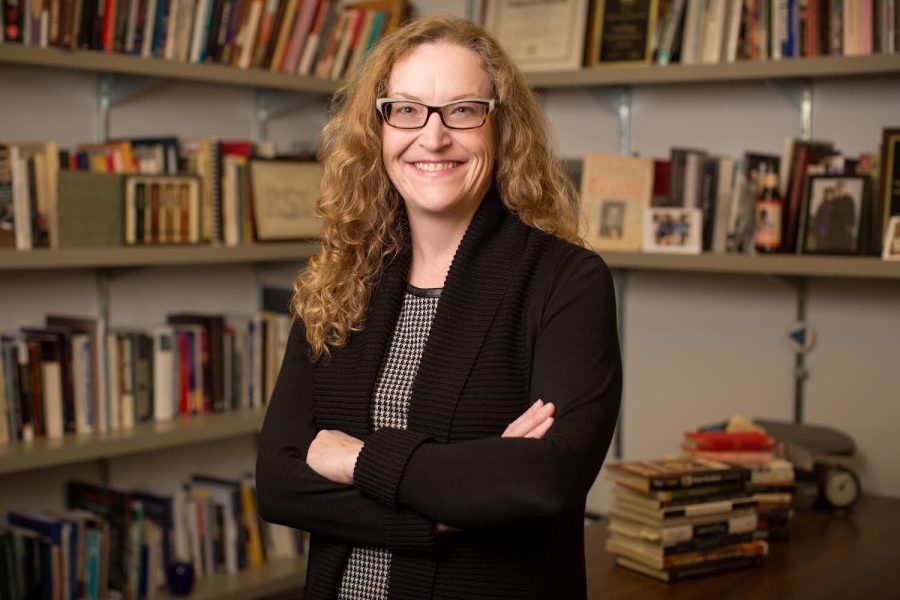Cara Finnegan sees life in photographs
Photo Courtesy of Brian Stauffer / UIUC Public Affairs
Professor Cara Finnegan poses for a photo in her office
May 15, 2020
Cara Finnegan, professor in LAS, looks at how visual media can sometimes speak to people more than words can. Her courses within the communications department on rhetoric and visual communication are for both undergraduates and graduates. The main focus of her work is exploring how photographs inform and influence our views of public and political life.
Over the years, Finnegan has been featured in the New York Times, among other popular media outlets and publications. Her published works range from examining the role of poverty in U.S. history to exploring the experiences of interpreters of historical pictures.
In the year 2021, her book “Photographic Presidents from Daguerreotype to Digital” will come out. In her book she says, “‘Photographic Presidents’ studies how presidents shaped and participated in transformative moments in the history of the medium, from John Quincy Adams, who in the early 1840s as an ex-president lamented in his diary his failure to get a good daguerreotype to Barack Obama, whose use of social media photography embodied the tensions inherent in early twenty-first century digital photography.”
Professor Finnegan explained that her research sparks from her pre-existing interest in “the ways that photographs gain meaning from the world around them, from the contexts in which they were produced, circulated and viewed by diverse audiences.”
She takes the example of our current COVID-19 predicament to elaborate on her perspective.
Get The Daily Illini in your inbox!
“A photo of people walking around a grocery store without masks on wouldn’t have raised an eyebrow six months ago, but now if you saw such an image you might think, ‘Oh, this is a photo of people refusing to wear masks in public during a global pandemic,’” Finnegan said.
What makes Professor Finnegan’s research so fascinating is the depth to which one can dive in the world of visual media. She said, “Visual images challenge and confuse us at every turn, which is one of the things that makes them so interesting to study.”
It seems that many share her attraction. Patrick Gorski, junior in LAS, elaborated on his thoughts about her research.
“Her research that is part of the CMN 340: Visual Politics class is astounding,” Gorski said. “The material breaks down photos to represent whole scopes of views that define history and those events through rhetorical actions.”
While she loves her research, Professor Finnegan mentioned in great detail the joy of teaching and interacting with her students. She recalls that one of the best things about doing what she does is when her course work really sticks with her students — when they can take away real-life applications.
She talked about how at the end of her CMN 340 classes, she encourages students to keep in contact throughout the years.
“And they do,” she said. “Students I had maybe 10 or 12 years ago will still drop me an email with a link to a news article or picture and say, ‘This reminded me of our class.’ I love that.”
Finnegan also enjoys being able to introduce her research into the public arena.
For the last two years, she had co-hosted the biweekly webcast “Chatting the Pictures” with Michael Shaw, one of her friends who runs a non-profit media literacy site called “Reading the Pictures.”
“He and I have collaborated for more than a decade, and our current webcast allows me to share my ideas about visual politics with an audience outside of academia and the classroom,” she said.
When asked about her motivations or if she had a motto she lived by she recalled something her mother had once told her: “Control what you can control.”
Thinking about this she said, “I try to remind myself that there are still things I can do. But I can’t do or control everything. Remembering this helps keep me focused and less anxious.”
She has shared this sentiment with her students as well. One student from her CMN 396: Photography and Public Life class is Brianna Stevens. Stevens, senior in LAS, highlighted some ways Professor Finnegan inspires her students.
“Professor Finnegan is someone who really goes above and beyond to help students learn,” Stevens said. “Her positive energy, creative class projects and examples and great depth of knowledge make taking a class with her a treat … I think Professor Finnegan’s research is extremely relevant in not only considering the historical impacts of photography and public life, but also in understanding the impacts they have today.”
“Her motivations are to strive in education and her focus on photography is stellar,” Gorski said.
Professor Finnegan described how her teaching extends outside your everyday textbook. Her love for undergraduates means she tries to help her students gain the skills and confidence they may require to visually interpret the world around them. When working with students, she said she tries to emphasize that their experiences in college help them develop life skills for the world after college.
“I want students to realize that college should not only be about classes and future careers, but also about exploring your enthusiasms and curiosities,” Finnegan said. “Taking that class outside of your major, joining that club that has nothing to do with your career plan, working that job that teaches you how to get along with all different kinds of people – all of those things are a big part of what makes college an important time.”






